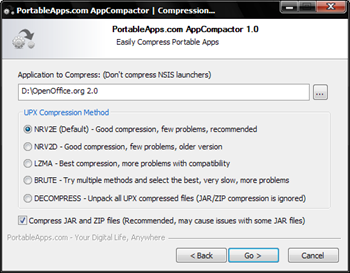PortableApps.com, the biggest resource for portable applications, has come up with an amazing application - AppCompactor. AppCompactor allows you to compress portable applications, reduce it's file size and increase performance when running from a slow media like a thumb drive.
AppCompactor packages UPX and 7-Zip within it allowing you to easily compress an app's EXEs, DLLs and other binaries using UPX and recompress ZIP and JAR files using 7-Zip, with four different compression methods to choose from - NRV2E, NRV2D, LZMA or BRUTE mode. It also has an option to DECOMPRESS an app's binary files that were previously compressed with UPX.
To compress an application, just select the directory and all the DLL, EXE, ZIP, JAR, IRC, PYD and BIN files within that directory will be compressed. Depending on the files, AppCompactor promises a size decrease by 50% or more without affecting functionality. Now for some test.
By using the default compression method, it reduced my Foxit Reader directory from 12 MB to 4.8 MB, a size reduction by 60%, and OpenOffice.Org from 250 MB to 188 MB. It shrunk Google Sketchup from 50 MB to 30 MB and Limewire from 16 MB to 7.5 MB. All these programs worked find even after compression.
Any application that is capable of working without installation, in essence, is a portable application. If you try to run your previously installed programs after a format and Windows reinstall, you will realize a lot of applications are in fact portable. The OpenOffice and Foxit Reader on my PC were normal installed applications, now working in the portable mode. AppCompcator works with all of these. Besides on a pen drive where space is limited, AppCompactor is godsend. (Thanks Download Squad)


Comments
Post a Comment